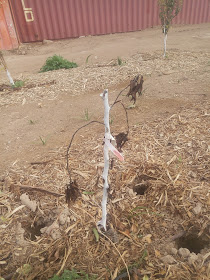A. In your climate late
summer and fall is a nice time to plant trees. Temperatures are in the upper
70’s during the day and dipping into the upper 40’s at night. So soil
temperatures are probably in the low 60’s; warm enough for good root growth and
establishment yet air temperatures are cool enough to slow the loss of water
from the leaves.
Fireblight would infect trees in the spring and the
symptoms usually appear in early summer. It is possible to transport this
disease to a healthy tree through pruning a sick tree and then pruning a
healthy tree without sanitizing the shears. But I doubt that is what is
happening.
It is most likely how it was planted. Maybe the roots got
too dry before it received water or it was planted with dry soil surrounding
the roots. Always soak the soil around the roots with water from a hose a few
times before turning it it over to an automatic irrigation system.
Some basic rules to
follow:
1. Make sure the hole is
at least three times the diameter of the container. If the soil is really bad,
make it 5 times.
2. Make sure water can
drain from the hole in half a day or less
3. Get the hole sopping
wet before planting
4. Amend the soil put back
in the hole with compost or other good soil amendment
5. Make sure this soil is
wet immediately after you shovel it into the planting hole. Put water in the hole
with a hose at the same time you are planting
5. Stake the tree after
planting so roots don’t move during strong winds
6. Build a basin or moat
around the tree to capture water from a hose
7. Water the plant twice,
immediately after you plant it
8. Water it with a hose
every other day for the first week to settle the soil around the roots.
9. Water once a week after planting with enough water to thoroughly wet
the soil around the roots to a depth of 18 to 24 inches.



No comments:
Post a Comment